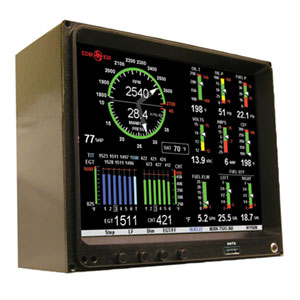 An aircraft engine monitoring system works along the same lines as a say an athlete hooked up to monitoring systems as he exercises in a gym. If any monitor indicates that a vital sign is above normal, the medical expert will decide on the necessary course of action. An aircraft engine monitoring system works along the same lines as a say an athlete hooked up to monitoring systems as he exercises in a gym. If any monitor indicates that a vital sign is above normal, the medical expert will decide on the necessary course of action.
In an aircraft it is the pilot(s) who will decide on what action to take when any monitor displays an abnormal reading. So where do these readings come from? Modern day aircraft have several sensors installed at vital places in the aircraft’s engine. For example, there are sensors monitoring engine temperature, oil pressure, and fuel pressure and so on. Each of these sensors are in turn are hooked up to either individual or a single digital monitor installed in the cockpit and capable of displaying information from single or multiple sensors.
As a matter of fact, each of these aircraft engine monitors is a specialized mini-computer all by itself. These monitors are programmable in that the pilot can feed upper limits for various sensors. So when data from a particular sensor indicates that its upper limit has been breached, the monitor will display a visual alarm and additionally, depending on the monitor model, it may also sound a audio warning. In simply terms, the aircraft engine monitor apart from continuously displaying the data from the sensors, also continuously compares the data to the upper limits set by the pilot or maintenance engineer.
Modern digital aircraft Fuel Gauges therefore free the pilot(s) from having to constantly monitor the aircraft system. They know that if something goes wrong, the aircraft engine monitoring system will bring it to their attention.
A constantly over-heating aircraft EDM Monitors for example, could be schedule for an early maintenance instead of waiting for its usual maintenance. The early maintenance will in turn catch the source of the problem before it becomes major or worse, becomes a threat to the lives of people in that plane. Also, the maintenance itself could be done at the designated repair facility instead of say, making an emergency landing in some foreign country and paying a lot more for emergency repairs. It is like catching a heart-attack before it occurs and becomes life-threatening.
Being mini-computers in themselves, modern Avionic Instruments systems also store the data onboard. This information can be retrieved and copied onto pen-drives or external hard drives for analysis by the aircraft maintenance staff.
Larger and expensive aircraft even have mid-flight data transmission feature. So even as the aircraft is in flight, accumulated data is transmitted at regular intervals to receiving ground stations monitored by maintenance staff.
In the event of a crash, data received by such ground stations could hold vital clues as to the cause of the crash. All in all, an aircraft engine monitoring system makes flying safer for the passengers while the aircraft owners benefit from avoiding expensive emergency repairs and also benefit economically because the aircraft’s lifespan is increased leading to better profits.
|